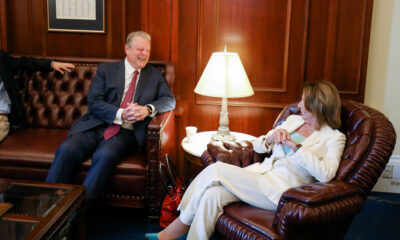Guest Columns
Dispelling Illusions About American Inequality
How a new book dispels illusions about inequality in America, including the false idea that poverty levels are stagnant.

The following review is part of RealClear Books & Culture’s symposium on The Myth of American Inequality,
Inequality will always be with us (Matthew 26:11)
As Alexis de Tocqueville never ceased to remind his readers, the mere fact of inequality bothers people. Whether it is expressed through legal privileges accorded to particular groups, or the reality that some people are more naturally gifted than others in fields ranging from sport to scholastic aptitude, disparities between human beings are a source of tension that never goes away.
One expression of inequality that especially agitates many people are differentials of wealth, property, and income. Since the mid-nineteenth century, these have aroused the enmity of the political left but also parts of the political right.
In vain do those of us who advocate for free markets point out that capitalism has steadily diminished poverty and underpinned tremendous advances in longevity and quality of life for all of us in ways unimaginable for eighteenth-century aristocrats and peasants alike. For, as Tocqueville also pointed out on several occasions, the fact of ongoing economic inequalities regularly crowds out attention to the reality that, with relatively minor exceptions, everyone is steadily better-off in market economies, notwithstanding the business cycle’s ups-and-downs.
This problem will always be with us as long as humans are human. Envy is a deeply unattractive vice, but that never prevents it from rearing its ugly face. That said, facts do matter, especially when it comes to challenging established narratives about inequality that have assumed the status of fact in the minds of legislators and citizens alike.
Giving the lie to two maxims of the left
Herein lies the importance of The Myth of American Inequality, authored by Phil Gramm, Robert Ekelund and John Early. It particularly challenges two claims that inform a great deal of American commentary on politics and economic inequality: that 1) there has not been a meaningful reduction in poverty in America since the 1960s; and 2) the living standards of the medium household have stagnated.
It is not difficult to find commentators across the political spectrum who regularly make these claims. To support such statements, they regularly reference decades of accumulated government statistics. Gramm, Ekelund, and Early, however, drive an intellectual bulldozer through these constructs by underscoring problems with the way these statistics are compiled and then interpreted.
In some cases, the authors make their arguments by drawing upon research that has involved auditing statistics, such as the General Population Survey “to check the accuracy of the reported income of those who reported extraordinarily low incomes.” Such research indicated that an astonishing “90 percent of these individuals were misclassified as extremely poor. Half of them were not even poor, and some were in the middle income quintile.”
What government statistics leave out
Leaving aside these and other issues of accuracy, there are also problems with what government statistics do not report. Gramm, Ekelund, and Early point out, for instance, that such statistical reports typically ignore “noncash” income sources. Most wealth transfers via social programs (i.e., entitlements and the like) are thus excluded. Yet, as the authors observe, such transfers have helped facilitate improvements in the living standards of those on society’s economic margins.
Another major problem with the same government statistics is that they exclude taxes. That matters because the wealthy pay taxes at a disproportionately higher rate than everyone else in America. This disproportionality has played a role, the authors stress, in leveling the distribution of consumption across American households. But this produced some paradoxes that turn arguments about American economic inequality upside down. Gramm, Ekelund, and Early show that there is an equality of consumption between the middle quintile (of which about 92% of prime-age persons work) and the bottom quintile (of which 36% of prime-age persons work).
Transfer payments pay people not to work
This means that some families have two adults working but earning the same as other families in which perhaps one adult or no adult is working. Perhaps there are specific reasons why no prime work-age adult in a given household is working. That said, the authors point out that “It is hard to see how a middle-income family with two adults both working would not resent the fact that other prime work-age people who are not working at all are just about as well off as they are.”
Making matters worse, the authors state, is that the growth of transfer payments since LBJ’s Great Society programs has had the effect of causing “a significant number of prime work-age people to become detached from the economy.” That has, they argue, resulted in some Americans not enjoying as much of the fruits of America’s extraordinary economic growth over the last fifty years. In other words, interventions to promote greater economic equality have actually resulted in substantive inequalities. Here I was reminded of the work of the political economist Nicholas Eberstadt. In books like Men Without Work (2016/2022), Eberstadt has shown how government benefit dependence is a major factor in explaining the consistent rise in the number of prime-age American men not working since the 1960s.
Inequality aside, poverty has declined
There is, however, a positive, even uplifting side to Gramm, Ekelund, and Early’s book. Once many of the problems with the compilation of government statistics are corrected, the authors show that there have been many positive developments vis-à-vis economic inequality in America. For example, the percentage of Americans in poverty in 1947 was 32%. That number fell to 15% in 1967 before declining to just 1.1% in 2017. Then there are the immense improvements in average living standards. According to Gramm, Ekelund, and Early, the bottom quintile’s real income increased by over 681% between 1967 to 2017. That is an astonishing achievement.
But what about the gap between those at the top of the income pile compared to those at the bottom? Here too Gramm, Ekelund, and Early point to good news. Americans are regularly told that top-quintile households enjoy an income equal to roughly 16.7 times that of the bottom. That proportion is, however, simply wrong, with the authors demonstrating that the top quintile’s income is actually four times that of the bottom.
As a moment’s glance at any newspaper today will quickly tell you, this and other pieces of good news are not well-known. But that points to another challenge. More than one person would argue that pointing out that the facts about American inequality contradict the rhetoric deployed by legislators and popular commentators is a forlorn exercise.
Appeals to the Seven Deadlies
People will believe what they want to believe, the argument goes, and political leaders and aspirants for public office will say what they need to say to try and get elected and stay in office. Whether we like it or not, some insist, appealing to people’s baser motives – including envy – lends force to those who insist that gross economic inequalities are rife and that “something must be done” (no matter how damaging or counterproductive such policies might be!) to rectify the situation. In the face of such powerful dynamics, appealing to facts isn’t likely to substantially shift opinion.
All this may be true. It is not, however, a good argument for refraining from pointing out the fallacies upon which the force of such rhetoric implicitly relies. Dismantling myths involves stating the truth, and starting debates often involves challenging the unexamined assumptions – whether empirical or normative – underpinning mistaken beliefs and the policies that often give effect to false convictions.
A constructive debate about inequality
That is why the ultimate objective of this book, Gramm, Ekelund, and Early state, is to spark a “constructive public policy debate on inequality, poverty, and our national and individual well-being.” The truth does indeed set us free, the authors state, but that means we “need to know the truth.”
Not everyone wants to know the truth about economic inequality in America. Such facts get in the way of demagogues and ideologues alike pursuing agendas that have little to do with America’s well-being. Nonetheless, “getting our facts straight,” the authors remind us, is an indispensable prerequisite for persuading those Americans who actually care about preserving the American Dream to cast off some significant illusions that cloud their vision. And that is always the first step towards illumination.
This article was originally published by RealClearBooks Symposium and made available via RealClearWire.
Samuel Gregg is Friedrich Hayek Chair in Economics and Economic History at the American Institute for Economic Research.
-

 Civilization4 days ago
Civilization4 days agoDC Pipe Bomb Arrest Raises Questions About Christopher’s Wray’s FBI
-

 Civilization5 days ago
Civilization5 days agoThe Legal Logic Behind U.S. Operations Against Narco-Terrorist Networks
-

 Executive5 days ago
Executive5 days agoNewsom’s ‘National Model’ for Homeless Wracked by Fraud
-

 Executive4 days ago
Executive4 days agoWhen You’re in a Hole, Stop Digging
-

 Executive2 days ago
Executive2 days agoWaste of the Day: Obamacare Failed Test, Approved Fraudulent Subsidies
-

 Education3 days ago
Education3 days agoWaste of the Day: Taxpayers Subsidize Football Coach Severance
-

 Civilization3 days ago
Civilization3 days agoPence Calls on Trump To Fire RFK Jr Over Abortion Drug
-

 Executive4 days ago
Executive4 days agoWaste of the Day: Feds Pay Nonprofits That Sue the Government












